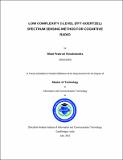| dc.contributor.advisor | Chakka, Vijaykumar | |
| dc.contributor.author | Bhatt, Prakruti Vinodchandra | |
| dc.date.accessioned | 2017-06-10T14:39:49Z | |
| dc.date.available | 2017-06-10T14:39:49Z | |
| dc.date.issued | 2012 | |
| dc.identifier.citation | Bhatt, Prakruti Vinodchandra (2012). Low complexity 2-level (FFT-GOERTZEL) spectrum sensing method for cognitive radio. Dhirubhai Ambani Institute of Information and Communication Technology, 61 p. (Acc.No: T00354) | |
| dc.identifier.uri | http://drsr.daiict.ac.in/handle/123456789/391 | |
| dc.description.abstract | Energy detection in frequency domain is a preferred technique for the spectrum sensing and
the accuracy of frequency estimation depends on the Discrete Fourier Transform (DFT) size.
Instead of computing full length (N) DFT of the whole data, a new two level (coarse-fine)
technique for energy detection is proposed. In the first (coarse) level, time averaging of
smaller size (L<<N) data blocks of the whole data and its DFT are computed and Neymen
Pearson based detection is performed to determine the presence of energy in the subbands.
In the second level (fine), Goertzel algorithm is applied to determine the fine estimates in
those subbands. Matlab based experiments are performed to verify the performance of
proposed method in terms of probability of correct detection and false alarm at different
noise levels. Simulation results show that this method can be applied for non-uniformly
occupied spectrum also. The complexity of this approach is evaluated and it is 51%
computationally more efficient for the considered case. Different windowing methods have
been evaluated to be used for better detection performance. It is shown that optimal Discrete
Prolate Spheroidal Sequence window helps in minimizing the spectral leakage to the adjacent
bands, hence reducing false alarms and improving frequency estimation for Cognitive radio.
Adaptive thresholding methods have been applied to the proposed detection method for
increasing the reliability of spectrum sensing and combating the problem of noise
uncertainity. Directions to extend the work further for case of Multipath fading environment
and spatial sensing have also been mentioned in the thesis | |
| dc.publisher | Dhirubhai Ambani Institute of Information and Communication Technology | |
| dc.subject | Opportunistic Spectrum Access | |
| dc.subject | Cognitive Radio Networks | |
| dc.subject | Radio spectrum | |
| dc.subject | Spectrum Sensing | |
| dc.subject | Usage detection | |
| dc.subject | Radio frequency allocation | |
| dc.classification.ddc | 621.384 BHA | |
| dc.title | Low complexity 2-level (FFT-GOERTZEL) spectrum sensing method for cognitive radio | |
| dc.type | Dissertation | |
| dc.degree | M. Tech | |
| dc.student.id | 201011019 | |
| dc.accession.number | T00354 | |

